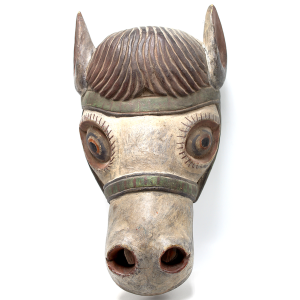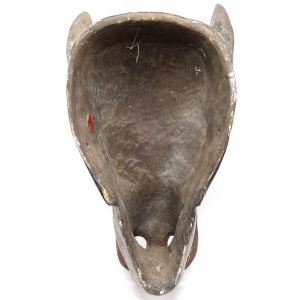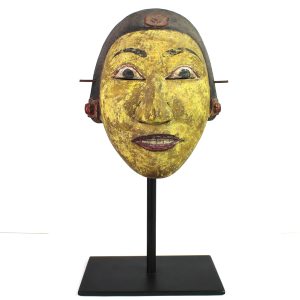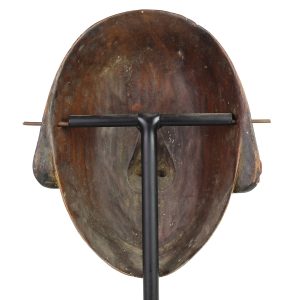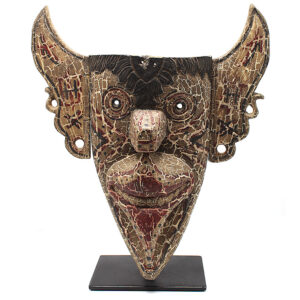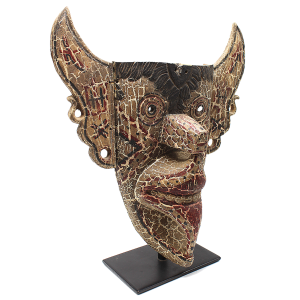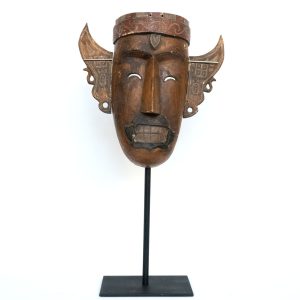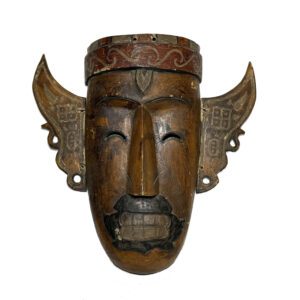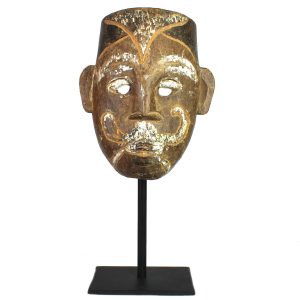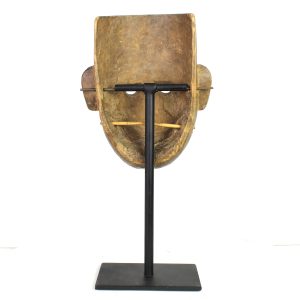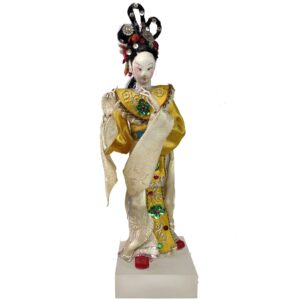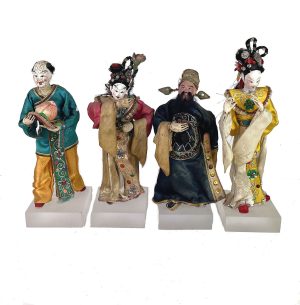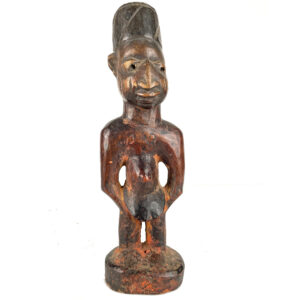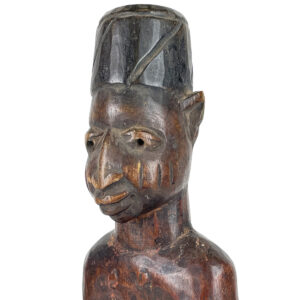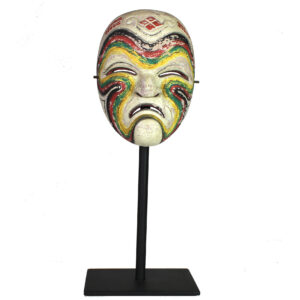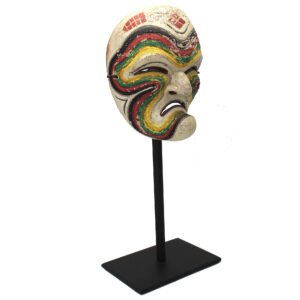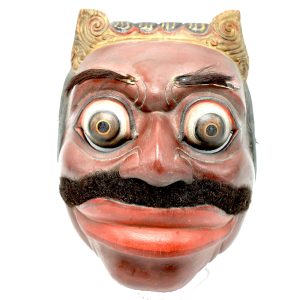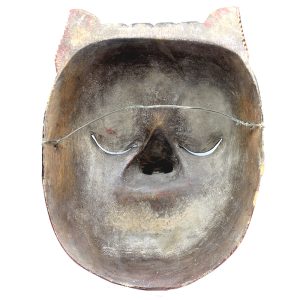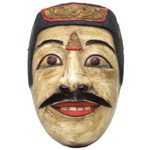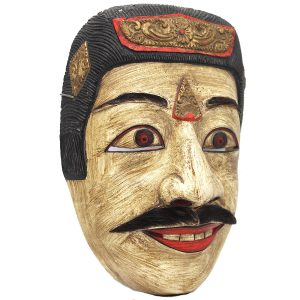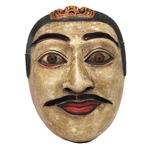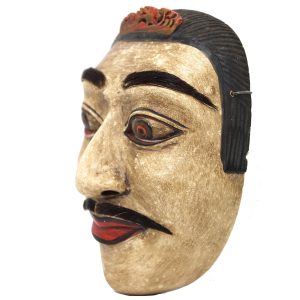Showing 109–120 of 135 results
-


$325.00
Deeply carved rows of black hair atop the horse’s head form a carved pattern framed by the upward-pointed ears that emphasize the horse’s alertness. Wonderfully modeled with flowing forms, this carving demonstrates the gifts of Tibetan woodcarvers. One can only imagine how important horses are to Tibetans living on “the roof of the world.” Without…
-


$675.00
Ht: 15.5” W: 8” D: 5” | CALL 213-568-3030 OR EMAIL [email protected] FOR SHIPPING
This charming Balinese mask is a traditional female Dayu, an ethnic Balinese high-caste Hindu Brahman Woman. This beautiful carving is too large to be a traditional dance mask , it is a beautiful decorative piece. Presented as a charming and beautiful woman from the top Hindu caste, she has delicate, detailed and sensitive features, that are superbly and subtlety carved. It is presented on a museum quality metal stand.
-


$485.00
The culture, rituals, tribal and ethnic art of the Dayak (Dyak) of Kalimantan (Borneo), Indonesia is a mix of shamanism, animism and ancestor worship. Dyak festival masks worn on the face or large ones attached to a costume repel malicious spirits from entering communal spaces, insure village safety, protect babies in their carriers and defend…
-


$1,050.00
H: 23.375” W: 13 W: 6” | FOR SHIPPING INFORMATION CONTACT US AT 213-568-3030 or [email protected]
This vintage hudoq Dayak ancestor mask has traditional Dayak features: wing-like separately carved ears attached with rattan that, like this, usually is replaced; long extended triangle nose, rounded arabesque-like ears and eye-holes, gnarled teeth, and geometric and curvilinear painted decorations. This one of three VA masks featured in collection of the Green Goblin in the 2002 Spiderman movie and is set on a museum-quality metal stand.
-


$675.00
The religion of the ethnic Dayak (Dyak) people of Kalimantan (Borneo), Indonesia is a mix of animism, shamanism and ancestor worship. Their word hudoq describes three different things: it describes the pests that can destroy the rice harvest on which their survival depends; the name of the huge yearly Dyak planting celebration and the name…
-
Sale!


$195.00 Original price was: $195.00.$135.00Current price is: $135.00.
H: 10.5 ” W: 3.5 ” D: 3.125″ | FREE SHIPPING WITHIN CONTINENTAL U.S.!
This charmingChinese Nuo Opera dancer wears a costume decorated with 5-petal plum blossoms symbolizing longevity and a wish for the Five Blessings or Happinesses: prosperity, long life, health, living a virtuous life and dying a natural death.
-
Sale!


$245.00 Original price was: $245.00.$150.00Current price is: $150.00.
Ht: 12” W: 4.125” D: 3.25” | FREE SHIPPING WITHIN CONTINENTAL U.S.!
Burmese heddle-pulleys are decorated with carvings of mythical or auspicious animals to provide protection and assure good quality weaving. A powerful ferocious Burmese Lion with open roaring mouth and thick main sits atop the pulley highlighting the area below where the weaving thread travels around the bobbin between the wood triangle pieces holding it. A fine folk art teak carving in excellent condition mounted on a a black wood base.
-


$385.00
Ibeji carvings from Nigeria are idealized folk art conforming to Yoruba artistic and cultural conventions without closely reflecting human likenesses. Symmetrical and restrained with oversized elongated heads where one’s spirit, intelligence and the seat of divine power lie, they often have detailed linear coiffures that can be a third or more of the figure’s body…
-


$1,050.00
Javanese Wayang (puppet theater) Topeng (literally “pressed against the face” or mask) is a very refined dance form accompanied by gamelan music. In Bali Topeng tua is the charming dance of an old courtier’s fragile movements, his lack of control and his gathering energy for a short lively dance. He sits behind a cloth curtain,…
-


$125.00
This ethnic and folk-art Bali legendary court minister (topeng patih) is performed in a special mask dance named Topeng Panjegan, as only one dancer interprets five different characters wearing full face masks preventing speech. Patih manis (Sweet Minister) is often the first solo dance after a gamelan orchestra introduction, and this patih keras (strong minister)…
-


$105.00
All ethnic mask (topeng) dances in Bali are accompanied with music from a gamelan percussion orchestra as are dramas and other entertainments considered as offerings to honor, please and attract the favor of the gods and ancestral spirits. In the west dancers put on masks to pretend they are someone else. Balinese dancers become the…
-


$110.00
Wearing a full mask of an ideal high-born Hindu king (dalem), dancers from Bali perform folk-art and ethnic-art dances without speech using only body language, gestures and movements to depict the mask’s character. Made from light and color-enhancing, easy to carve and durable pulai wood, Balinese-masks (topeng) honor and attract the favor of gods and…
End of content
End of content

